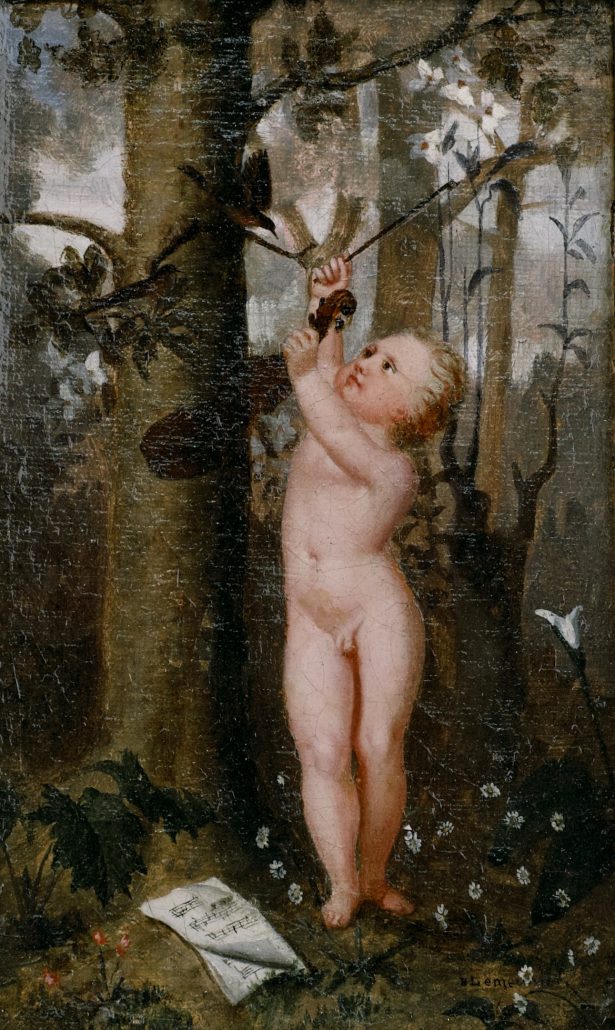Basile Lemeunier
1852 – 1922
French School
Mozart enfant, génie de la musique, dirige monsieur l’étourneau avec son arc (The Child Mozart, a Spirit of Music, Conducts the Starling with his bow), May 1872.
Oil on canvas. 15 x 9 cm
Signed lower right: Lemeunier.
Old annotation in ink on the stretcher (in the artist’s hand?):
Mozart enfant, génie de la musique, dirigeant monsieur. l’étourneau avec son arc. Mai, 1872.
Lemeunier was born in the small Normandy village of Antoigny, 40 km to the north east of Mayenne. As a young man he started by painting the walls of his parent’s house before purportedly moving on to paint « all the walls of the village ». He was soon taking commissions for portraits from clients in Mayenne. His talents were recognized by the local authorities, who awarded him a two-year scholarlship to pursue his studies in Paris. Once installed in the capital, Lemeunier entered the studio of the great military painter, Edouard Detaille, while also attending classes given by the painter, Amédée Hédin.
By 1888, he was sending work to the Paris Salon and he continued to do so until the year preceding his death. Lemeunier’s works received awards in 1891 and 1907 and also at the Expositions Universelles of 1889 and 1900. He became a close friend of Detaille and he also worked as studio assistant for the artist’s major projects, such as the decoration of the Pantheon in Paris, squaring designs for transfer and collaborating with him in the execution of decorative friezes. Lemeunier’s personal work consisted of portraits and scenes from contemporary life, including genre scenes and Paris street scenes.
The present composition is a youthful allegory by the artist. Miniature in format, precious and exquisitely rendered, it depicts the infant prodigy, Mozart, as a genie of music. In the pink of health, the child’s nudity underscores innocence and close proximity to nature, while in marked contrast, his elaborate coiffure signifies rococo sophistication and civilization.
On May 27, 1784, Mozart purchased a starling (the common name for the European Sturnus vulgaris.) Three years later, he buried it with much ceremony. Heavily veiled mourners marched in a procession, sang hymns and listened to a graveside recitation of the lengthy poem Mozart had composed for the occasion, excerpted below:
Ich wett, er ist schon oben, Um mich zu loben Für diesen Freundschaftsdienst Ohne Gewinnst.
I wager that he is already on high Praising me by friendly service Without pay.
Some scholars have found it astonishing that the death of a bird could be the genuine object of the composer’s grief, and they cite another event in the same week as being the more likely cause for Mozart’s funeareal gestures: the death of his father, Leopold.
When Mozart purchased his starling, it was already able to whistle the principal theme of the final movement of his Piano concerto n° 17 (K.453). Probably a fast learner, it seems to have have picked up the catchy tune from Mozart himself after an initial contact and possibly even a single hearing (as talented starlings are sometimes wont to do.) However, the bird altered the theme rhythmically, and it changed one of the notes, giving an amusing twist to the otherwise straightforward diatonic melody.
Eight days after Mozart’s bird died, he completed Ein musikalischer Spass (A Musical Joke, K. 522), a piece consisting of abrupt cesurae and awkwardly disjointed phrases that are illogically joined together, all of which produce a curious comical effect. While the piece is most often interpreted as a satire of the musical conventions of the day and the talentless composers that slavishly adhered to them, it may also have served as a musical farewell – a requiem of sorts – for Mozart’s avian friend.
In Lemeunier’s allegory, an eden of flowers accompanies the divine harmonies of Mozart’s violin and the enthusiastic songbird that echoes them: a calla lily (purity and beauty), daisies (simplicity), grape
leaves (sensual pleasure, the Dionysian), anemones (eternal love) and orange nasturtia (the hero’s flower.)
REFERENCES
1. American Scientist: Mozart’s Starling, Merideth West and Andrew P. King, March-April, 1990.

